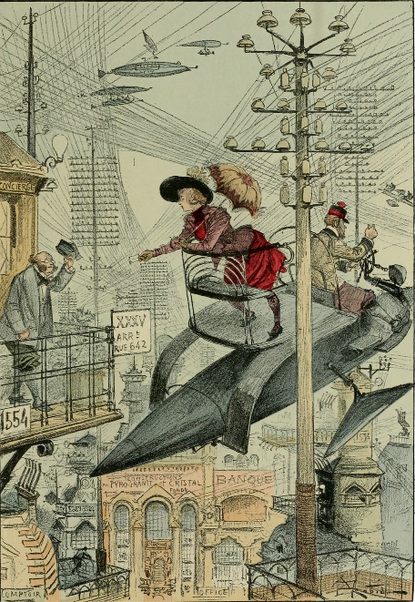The Jewish theme in the works of Odessa artists of the XIX-XXI centuries: from Leonid Pasternak to Aleksandr Roitburd
In November 2001 the Odessa Museum of Art exhibited a show titled “Anticipating a Miracle” – works by Jewish artists from Odessa from XIX-XX century. The show became an instant headline-maker, since despite the abundance of Jewish artists in this city a show like this never took place neither in Soviet times (which is not too strange taking into account the anti-Semitism inherent to that era), nor in the epoch of Revolution and civil war. It is worth mentioning that a show like this was in the plans as early as 1918, but because of the turmoil of those years it remained at its early stages. As a result, our artists took part in similar shows in Kyiv, Moscow and Petrograd in 1918-1919.
Since the mid-XIX century, ever since the dawn of Odessa’s artistic tradition, throughout its history and up to today, the contribution of the Jewish masters has been extremely significant. Both as artist groups and individually, such artists as Leonid Pasternak, Solomon Kishinevsky, Iosif Braz, Iosif Konstantinovsky, Philip Goziason, Mikhail Solomonov, Amshei Nurenberg, Isaac Malik, Moisei Pfeferkorn, Vladimir Baranov-Rossine, Isaac Brodsky, Yulij Bershadsky, Mikhail Gershenfeld, Sandro Fasini, Teofil Fraerman, Israel Meksin, Dina Frumina, Moisei Mutselmacher, Ilia Shenker, Liudmila Tokareva-Aleksandrovich, Lev Mezhberg, Moisei Chereshnia, Aleksandr Freidin, Iosif Ostrovsky, Lucien Dulfan, Leonid Gerwitz, David Bekker, Efim Ladyzhensky, Grigory Palatnikov, Yuri Zilberberg, Leonid Voitsekhov, David Tikholuz, Ilia Zomb, Aleksands Roitburd and others made their significant mark .
This is far from being a complete list, but even this is enough to show the significance of Jewish artists’ contribution to the cultural heritage not only of this region, but also of many countries – from Russia to France and Israel. So why did the Odessits have to wait at least a hundred years for the works of these artists to be brought together in one show in Odessa? This question can be answered in many different ways, with the most obvious one being “because of anti-Semitism in its different forms”.
In the foreword to the catalogue for the Anticipating a Miracle show, art historian and director of the Museum for Jewish History in Odessa, Mikhail Rashkovetsky, writes: “It has to be taken into account, that due to many circumstances (the main ones being the Holocaust itself and the anti-Semitism propagated during the times of the Soviet rule), many works of a ‘Jewish’ subject-matter dating from the first half of the XX century were simply destroyed. It can be assumed that most of these works were part of the Mendel Moikher-Sforim First All-Ukrainian Museum of Jewish Culture collection, which disappeared without a trace (unlike the works of decorative art which were recently named part of the Museum of Historical Riches of Ukraine collection).”
The fait of most of the works of art by Jewish masters of the XIX-XX century was less than fortunate: first the revolution, then civil war, change of the city government and in about 20 years – Romanian occupation. The number of those who disappeared, got killed and died is hundreds, if not thousands. In the dark days of the war not only private collections were taken apart and robbed of many of their pieces – Odessa museums also experiences substantial losses. And, of course, the works by Jewish artist were among the first to be vandalized: those that survived were part of private or museum collections in other cities or countries. Several years ago a great surprise and pleasure for Odessa art-lovers became a show at the Ramat Gan Museum of Russian Art: its curator, Lesia Voiskun, organized Odessa’s Independent, - a show of works by artists from 1920-30s, the works of which disappeared from Odessa collections but miraculously survived in Israel: in 1919 Jacob Peremen, a collector from Odessa who emigrated on the now famous Ruslan ship, took them with him. Among other people on that same ship to Eretz Yisrael were history professor Joseph Klausner, architect Ieguda Magidovich, artist Iosif Konstantinovsky, and many others. No wonder Ruslan later got the named “The Mayflower of Zionism”. Jacob Peremen managed to save around 220 works of Jewish artists from Odessa, among which are pieces by such bright stars as Teofil Fraerman, Isaac Malik, Sandro Fasini, Amshei Nurenberg. If it weren’t for Peremen, these works most certainly would have disappeared forever.
Not only works, but also their authors were bound to a dramatic fait. Solomon Kishinevsky died in a Jewish ghetto at the very beginning of the occupation; Sandro Fasini and Vladimir Baranov-Rossine, who emigrated to France – died in fascist camps in a foreign land. Therefore the joy of art-lovers, collectors, gallerists and many others is quite understandable when it comes to bringing the works of these artists in one show.
There were other shows to follow the one at Ramat Gan: a show of monochrome graphics by Jewish artists at the World Odessit Club in 2007 (works by Solomon Kishinevsky, Sandro Fasini, Amshei Nurenberg, Philip Goziason, as well as contemporary Odessa artists – Lev Mezhberg, Aleksandr Freidin, Yuri Zilberberg, Grigorii Palatnikov and others); show of works by Jewish artists form the Sergei Kanivetz Collection at the Beit Grand Jewish centre in 2010 (mostly works by unknown artists depicting inhabitants of the town of Medzhibozh, several works by Mikhail Gershenfeld, Moisei Mutselmacher, Solomon Kishinevsky, Boris Egiz); a show of works by Joseph Ostrovsky, David Tikholuz, Sofia Rashkova, Amshei Nurenberg. In 1993 the Kyiv House of Artists hosted Nisayon. Test. The Jewish question in the work of contemporary Ukrainian artists, which included works by such Odessa artists as Lucien Dulfan, Joseph Ostrovsky, Aleksandra Roitburd. After 70 years of silence the voices of these artists could now be distinctly heard.
Despite the silence during all these decades the tradition still lived on. Jewish artists became tutors and professors and passed their knowledge, talent and taste on to their students. Odessa has several generations of such tutors. For example Teofil Fraerman and Mikhail Gershenfeld, who came back after the February Revolution, taught Moisei Mutselmacher, Dina Frumina, Liudmila Tokareva-Aleksandrovitch, Aleksandr Postel, all of whom in their turn became teachers to Lucien Dulfan, Lev Mezhberg, Ilia Shenker, Joseph Ostrovsky, Aleksandr Freidin. Leonid Muchnik and Yuli Bershadsky also taught at the Odessa School of Art.
Jewish artists and the Jewish question are obviously notions very much connected, but far from identical. Odessa has always been an international city, an emancipated city. Therefore local artists always strived to work in accordance with European trends, and, funnily enough, the limitations and prohibitions, which were imposed by the Imperial state, only helped this: it was almost impossible for Jewish artists to make their way into the Saint-Petersburg Art Academy, therefore many of them, having graduated from the Odessa School of Drawing, went off to study in Munich, Paris, Rome. Among those who left to get an education in the West were Pasternak, Braz, Kishinevsky, Fraerman, Nurenberg, Gershenfeld, Baranov-Rossine, Fasini.
That is why not all artists of Jewish origin include the Jewish topic into the list of their subject matters. However, there always were, are and will be artists who treat this topic with great respect and interest, some even focusing on the Jewish question as the main topic of their work.
I must say right away that I will be treating the term “Jewish topic/theme/question” extremely broadly, not limiting it to the framework of the Jewish tradition or that of the canon or the Bible. In this article the Jewish question refers to the themes and subject matters one way or the other connected to the life and history of the Jewish people and reflected in artworks, - be it portraits of important figures for the Zionist movement or scenes from everyday life of Jewish families or small towns.
Out of all the Jewish artists from the last century I chose 6 (maybe this has something to do with the number of beams David’s star has?), to my point of view, most interesting and striking examples; artists, who addressed the issues connected to Jews most prominently in their work. They are Leonid Pasternak, Solomon Kishinevsky, Teofil Fraerman, Amshei Nurenberg, Joseph Ostrovsky and Aleksandr Roitburd. It is their personas and their art that I want to examine closely.

Portrait of Rainer Maria Rilke by Leonid Pasternak.
Leonid Osipovitch (Abraham Leyb, Itshok) Pasternak is mostly famous today as the father of Boris Pasternak, a great poet of the XX century. However, after even a brief look at his biography one can right away tell that he is the father of his son – so great are the personalities of both. Born in Odessa in 1862 and having graduated from the Odessa School of Drawing in 1881, Leonid Pasternak (together with his close friend Solomon Kishinevsky) leaves for Munich to receive his further art education there, at the Royal Academy or Art, since there was no way he could possibly get into a similar school in Saint-Petersburg. Having graduated in 1885 he comes back to Odessa where his career takes an immediate launch: in just four short years Tretyakov himself buys Pasternak’s painting News for the Front for his own gallery. The artist gives his another work – a drawing titled Jewish Girl Making a Stocking – to Tretyakov as a present. That same year, in 1889, Leonid Osipovitch moves to Moscow where he meets Leo Tolstoy, makes numerous portraits of the writer and illustrates his novel Ressurection. The artists is very productive, takes part in many shows, but still comes back to spend all his summers in Odessa. Pasternak becomes friends with Rainer Maria Rilke and Hayim Nahman Bialik, whose portraits he will go on to paint many times. Pasternak’s portraits can actually become a separate topic for research; among those who became his subjects are Albert Einstein, Shaul Tchernichovsky, Khaim Weitsman, Maxim Gorky, Leo Shestov.

The artist never forgot about his origin. In 1900 he took part in preparing a literary volume aimed to aid Jews from Bessarabia and South region of the country which fell victims to famine. Between 1918-1920 he works on Rembrant and the Jewish topic in his art, a book that would be published in 1923 in Berlin (where he moved in 1921). Around the same time his Portraits of Prominent Jews album gets published; in 1924 the artist visit Palestine and comes back together with Hayim Nahman Bialik; in late 1920s he shows his drawings and etudes from this trip in Tel-Aviv.

An interesting detail – in 1894 Leonid Pasternak was offered a professor’s post at the Moscow college of painting, sculpture and architecture on one condition: he had to convert to Christiannity. Pasternak declined. In his letter he said: “I grew up in a Jewish family and will never trade my Jewishness for career or any improvement of my social status for that matter.” In the end he was still made a professor of that institution and remained on that post for almost a quarter of a century.
In 1936-37 the artist tried organized a show that would commemorate his 75th birthday, and even though works chosen to be part of the show were already transported to the USSR embassy in Berlin in order to be taken to Moscow, Pasternak unexpectedly left for Oxford, where his younger daughter Lidia lived, instead of going to Moscow. He would never return back to the Soviet Union (which was probably for the best). He died in Oxford in 1945.
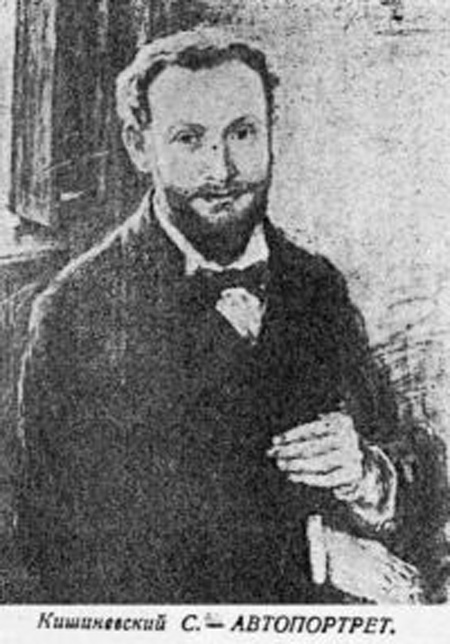
Solomon Yakovlevitch Kishinevsky
Solomon Yakovlevitch Kishinevsky was born in 1864 in Odessa. He entered the Odessa School of Drawing in 1864, among his tutors were sculptor Iorini and landscapist Bauer – representatives of the first generation of Odessa artists-tutors. Having graduated in 1883 and having received three honorary medals during his studies, he continues his education in Munich, where to he leaves together with Pasternak: they have a common cause to leave – they can’t continue their education in Russian Empire’s capital because of their origin. After Munich he studies at the free academy in Rome, and in 1888 graduates from the Paris Academy of Arts. He comes back to Odessa the same year to actively take part in local shows. In 1889 he makes his painting Appeal which is bought by Tretyakov in 1893. Solomon Kishinevsky taught at the Odessa Art Institute, illustrated the Odessa News newspaper, the Southern Theatrical Education magazine, using Benvenutto as his pen-name himself wrote about art and events in the city.
Two big shows, dedicated to his 40th and 50th jubilee consequently, took place in Odessa in 1929 and 1938 respectfully; the second show took place at the Museum of Russian and Ukrainian Art and consisted of more than 200 works from both private and state collections.
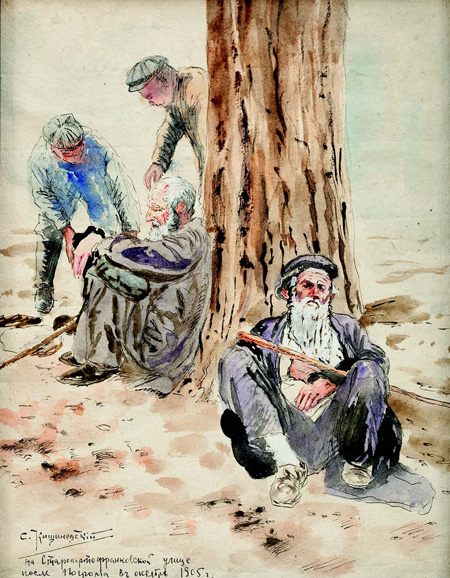
The Jewish theme is present in his works throughout his career. When he was 9 his family became a pogrom victim and that memory remained in his mind forever. He will develop this theme in many of his future works, and event though he never produced an epic work devoted to the subject, numerous sketches give an idea as to what it was supposed to be. The artist started working on this painting around 1910. In these sketches the artist depicted Jewish women, old people, students from the self-defence unit. The sketches were kept at the Revolution Museums in Kyiv, Odessa and Kharkiv. At the 1938 show another set of sketches was presented, the one created between 1929 and 1938. Among other subject matters, one could find portraits as well as scenes from everyday life of small Jewish towns: A Jew Reading (1905), Morgulis Portrait (1904), Two Jews and a Jewish Woman, Jewish Tailor (both 1905), Rabbi (1911).
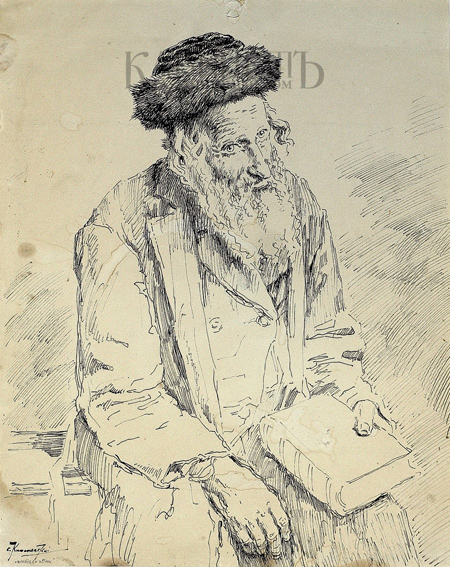
Odessa News from Novemner 17 (30) 1913 writes that Kishinevsky was working on a project of a memorial for the sadly famous “Bailis Case”.
Solomon Kishinevsky stayed in Nazi-occupied Odessa and died in a ghetto in 1941-1942.
Teofil Borisovitch Fraerman – a persona quite legendary in Odessa art circles. A great artists and tutor, he was a teacher to key artists not only of local, but nation-wide fame and importance: Evgeni Kibrik, Yuri Egorov, Oleg Sokolov, Dina Frumina, Ilia Shenker. Even Valentin Hrushch, who was never Fraerman’s pupil, having visited a show of the works by this master, said that he also considers himself one of his tutees. Almost all of Fraerman’s students made written notes about him in which they describe him and the time spent with him in respectful and warm words.
Teofil Fraerman was born in 1883 in Berdichev and moved to Odessa when he was 14. That same year he started his studies at the Odessa School of Drawing and after graduating in 1897 went to art-college to study under the supervision of Kyriak Kostandi. In 1902 he, like many other Jewish artist of that time, moves to Munich to study at the Aschbe school, then moves to Paris only to stay there for the next 8 years (1906-1914). In the forward to the Odessa Independent show catalogue, Lesia Voiskun writes that Fraerman studied at L’Ecole des Beaux-Art under the supervision of Gabrielle Ferrieux, who was famous fro his strict approach to education.
In 2008 Fraerman’s works appear at the Salon d’Automne, attracting a lot of attention to his persona among the art-world: next year he is invited to be part of the Jury of that same Salon. He is friends with Matisse, Rodin, he works with Degas, shows at the Salon des Indépendants. In 1914 Fraerman moves to London and in 1917 returns to Odessa to take care of his sick mother. He didn’t think he would be coming back for long, but as it turned out – he would never leave again. Odessa’s art-scene of that time was divided between the old generation of ‘traditionalists’ and the new ‘independent’ artists. Fraerman, of course, becomes associated with the latter and develops close friendships with Nurenberg and Gershenfeld, takes part in group shows with these artists. It is then that the ideas - such as immigrating to Eretz Yisrael and establishing an art-academy there, organizing in Odessa a show of works by Jewish artists – many of which were not destined to come true, appear. Fraerman, though, does get a chance to show off his organizational skills: he founds the National Museum of Art, the Museum for Jewish Culture, and according to some – even the Museum for New Art. Old painting Gallery of the Museum for National Art was to become the Odessa Museum of Western and Eastern Art, and Teofil Fraerman was its first director. He lived in the museum-provided apartment all his life, accept for the period between 1941 and 1944 when he was in charge of evacuating the collection to Ufa. After coming back to Odessa he takes up teaching at the Odessa professional school of art and other institutions and is granted professorship. At the same time his ‘European’ artistic upbringing never disappears from his works and in 1949, because of political reasons, he is banned from teaching. A very little amount of works by Fraerman have survived till today, but those that have show that the colourful and full of life artist who can be seen in the early works of Fraerman, has vanished. It is only a year before his death, during the Khrushchev era, that the artist comes back to his early techniques and makes a series of gouaches very much representative of his works done during his travels. These works were shows at the artist’s post-mortem retrospective in 1957.
Ilia Shenker, a student of Teofil Fraerman: “Not everyone immigrated, and among those who didn’t was Teofil Fraerman who lived in Odessa. I was lucky enough to become his student. He hated the Soviets and told us many stories about his travels through Europe and life in Paris. Italy and France were Heaven for him. He was a very educated and intelligent man, a real man. This shows that Odessa in the time of my youth was a city very vibrant, with a long-lasting artistic tradition and creative atmosphere.”
According to Mikhail Rashkovetsky, Fraerman’s students (official and unofficial) managed to incorporate something special in their woks that gave art-historians a precedent to talk about the “Odessa school of painting” in 1960-70. Fraerman, in a way, kept the artistic tradition of the early XX century alive in Odessa.
An incredibly small amount of works by Fraerman survived till today. It is only through reproductions of postcards that we can see how his famous Jewish Tailor looked like. Other Jewish-themed works, unfortunately, are lost. The pastel Portrait of the Unknown is exhibited at the Museum of Odessa Jews History, and the 12 works that miraculously survived as part of the Jacob Peremen Collection in Israel (among which Head of Jesus, Prophet, Head of John, Giraffe and others) became a huge discovery for the admirers of Fraerman’s art.
Let’s hope that these are not the last time that such works surface, since the interest towards Fraerman’s art in rapidly growing.
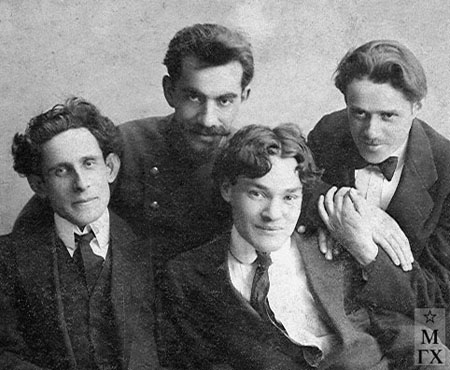
Midler, Yukhnevytch, Nürenberg, Malik
Amshey Nurenberg was born in Elisavetgrad in 1887. Between 1904 and 1910 studied at the Odessa School of Art under Kiryak Konstadi, afterwards leaving for Paris and coming back to Odessa in 1913 because of health problems. Films following his life and biography would be a goldmine for any director because his life was full of interesting turns and events. He shared his Paris studio with Marc Chagall, whith whom he kept in contact throughout his life; was an active member of the Odessa’s independent movement and was even about to leave for Palestine together with Jacob Peremen and found the Academy of Modern Art; was a great supporter of the Revolution and in 1917 was in charge of monuments conservation in Odessa; many times faced death and then miraculously escaped it; worked with Mayakovski; was friends with Babel, Ilf, Fasini, Konchalovsky, Grabar, Tatlin, Lentulov. Nurenberg was not only a talented artist, but also a talented writer who left meticulous notes about his life, which were later published by his grand-daughter Olga Tangian-Trifonova. These notes show the artists’ personality and character – lively and optimistic. He dies in Moscow at the age of 91, having outlived both his wife and daughter. In 2009 the World Odessits Club held a show of copies of his graphic works dedicated to Judaic.
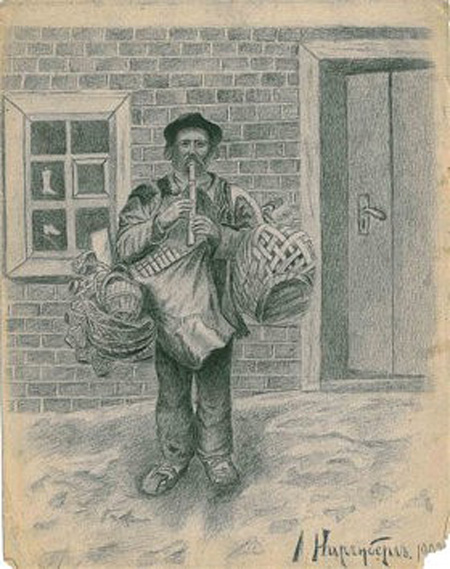
The Jewish topic is present in Nurenberg’s art throughout his life, which can be seen in his works, many of which were exhibited in Odessa: Street Vendor and Musician (1908), a series of drawings from Vinnitsa from between 1926-1929 (After the Pogrom, Teacher from Vinnitsa, Clock-maker, Old Man at a Table); Resting Woman-worker from a Jewish Kolkhoz (drawing from 1936); Old Man from Jerusalem (1938); Tailor-philosopher (1943). In 1963 Amshey Nurenberg goes to Pereyaslav, to the birth-place of Sholem Aleichem and later that year makes a whole series of drawings based on Aleichem’s writings. One of the works – Sholem Aleichem with his Characters – was reproduced as part of Nurenberg’s memoir “Amshey Nurenberg. Odessa-Paris-Moscow”, which was published in Moscow in 2010.
A new wave of interest towards the work of Nurenberg began in 2006, when a show of works by “Odessa Parisians” from the Peremen collection opened in Israel. On April 22, 2010, 1/3 of that collection (86 works) was bought by the Ukrainian Avant-Garde Art Foundation (founded by Andrei Adamovsky) at a Sotheby’s auction. Then, between June 14 and 29, 2011, the Russian-American Cultural Foundation opened Art of Ukranian Avant-Garde: Odessa Parisians show, as part of the “Our Heritage” festival. The press release for the show stated: “The show brings together works by artists from the “Society of independent artists” – an avant-garde group, founded in Odessa around 1910. Works are kindly presented by the Boris Fuksman, Andrei Adamovsky and Aleksandr Suslensky collections.” So as one can see – the interest towards the art of Nurenberg and other Odessa artists is far from low.
By the way, the only surviving portrait of Jacob Peremen was done after a sketch by Amchey Nurenberg.

The name of Iosif Ostrovsky right away comes to mind when thinking of a contemporary Odessa artist incorporating the Jewish topic into his work. If for many Jewish artists the topic is one way or another present in their work, then for Iosif Ostrovsky it became a key, central theme. The Jewish Cycle from late 70s – early 90s became crucial in his artistic heritage. Several hundreds of his works are now in museum and private collections in Ukraine, Russia, Israel, USA, Japan, Italy and other countries. In order to show just how popular his works are, it is worth mentioning the names of some of the private collectors who own works by Ostrovsky: Arcady and Kostantin Raikin, Pyotr Todorovsky, Zinoviy Gerdt, Mikhail Kozakov, Aleksandr Kaidanovsky, Mikhail Zhvanetsky. An interesting fact – during the mass immigration from Odessa in the early 90s, relatives who were already “there” wrote: “Don’t take too much with you, take just linen and the Ostrovsky.”
Iosif Ostrovsky was born in 1935 in a Shepetivka suburb, a Jewish town of Sudilkovo. Many inhabitants of Shepetivka followed tradition, celebrated Shabbat, went to the synagogue, men studied the Torah and the Talmud. Iosif’s mother respected the laws of Kashrut and lit the Shabbat candles.

Having turned 15 Ostrovsky moves to Odessa and enters the Odessa College of Art. He is supervised by Dina Frumina and Liubov Tokareva-Aleksandrovitch. After serving in the army he comes back to Odessa and lives there until 1989, almost 40 years. A talented painter and a great master of drawing, he quickly gains recognition and with that – governmental orders. In March 1978 the Odessa Museum for Western and Eastern art hosted a show of 130 of his works. From the works it was clear how the artist tried to find his own distinct style, subject-matter and techniques, as if going through different ones in order to find a perfect way of expression (he firmly rejects the “Soviet” way of painting). Around that time he starts working on his Jewish Cycle, the works from which he doesn’t show to anyone and keeps in his studio. Once, he invites Evgenii Golubovsky over, a local Odessa journalist, “for a couple of hours” to visit his studio, and shows him the works. “We spent the entire day in the studio, - writes Golubovsky, - a couple of hours weren’t enough: I saw a different Ostrovsky, someone who continued the traditions of Jewish painting, a wise master whose inner world was so in tune with those of Solomon Mikhoels , Benjamin Zuskin and even Mykhailo Kotsiubynsky. As soon as I saw those works I immediately decided that they need to be shown – the stereotype of the “Soviet Ostrovsky” should be broken in order to show that Jewish art is still alive in Odessa long time after Fraerman, art no less sophisticated but less cold and more humane».

Golubovsky introduces Ostrovsky to Note Lurie, a Jewish poet living in Odessa who at that time was on the editorial board of Sowjetische Heimland, the only Jewish magazine in Soviet Union, and in 1984, at the Moscow office of the publication, Ostrovky’s Jewish Cycle is exhibited for the first time. It was quite a brave step, since a couple of years earlier some “art-historians” visited his studio and were interested particularly in the works form this series. It is only thanks to the head of the Odessa Artists Union, Viacheslav Bozhii, who managed to convince the KGB that “these works are nationalistic in their form and socialist in their content”, that Ostrovsky (and his works) were left untouched. In 1988, this time in Odessa Museum of Art, Ostrovsky’s works are exhibited together with pieces by Oleg Voloshynov, Yuri Kovalenko and Evgenii Rakhmanin, as part of the Show of Four group exhibition. Ostrovsky then showed 30 works – all from the Jewish Cycle. He finally ‘came out’.
Mikhail Rashkovetsky in his article “Iosif Ostrovsky’s “Jewish Dreams””, writes: “The Jewish Cycle of late 1970s - early 1990s undoubtedly takes a central place in Ostrovsky’s heritage. It is through this cycle that his entire body of work makes sense and gains value. Ostrovsky himself compared the images from his canvases to those of dreams and memories coming back from afar hardly identifiable with a specific place or time. These are ‘dream-memories’ about oneself, about real human nature. They were “torturing” Ostrovsky for a long time, didn’t let him be. Without putting them on canvas he could never become a real artist.”
In 1989 Iosif Ostrovsky together with his family moves to Israel. He continues working, takes part in shows and become the main artist of the Sderot city. But his health continues to deteriorate, and although Israeli doctors manage to give him four more years of life, he dies in 1993 at the age of 58.
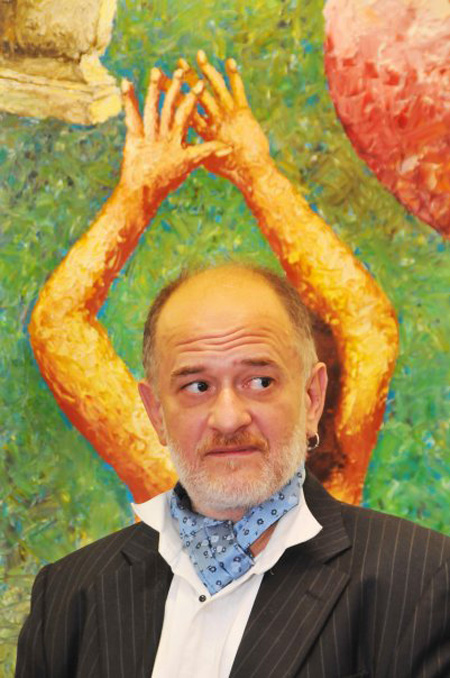
Aleksandr Roitburd
Aleksandr Roitburd is probably the most famous Odessa artist today. He does, though, live mostly in Kyiv. Until lately his Good bye, Caravaggio, having been sold at a Philips de Pury auction, was the most expensive work ever sold by a Ukrainian artist at auction.
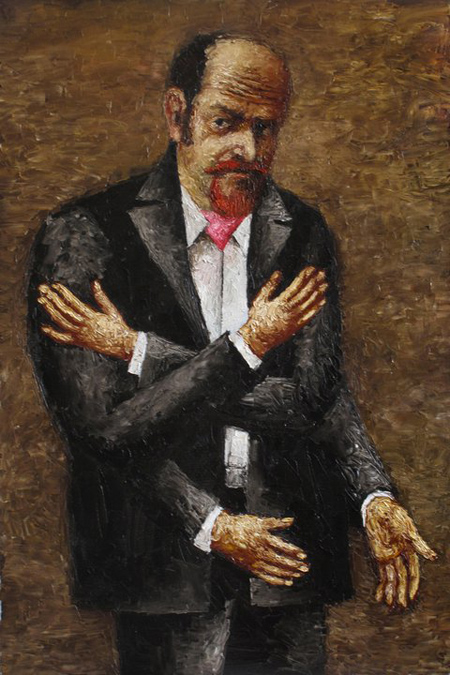
Aleksandr Roitburd. Self-portrait.
Aleksandr Roitburd was born in 1961 in Odessa and graduated form the Painting and Graphics School of the Odessa Pedagogic Institute, where he studied under Valerii Gegamian, in 1983. In late 80s, together with his fellow students Vasilii Riabchenko and Sergei Lykov, and together with Elena Nekrasova, he creates the trans-avant-garde art group, which quickly becomes a widely-discussed Odessa phenomenon. In early 90s Roitburd and Mikhail Rashkovetsky found the “New Art” association, which later led to the opening of the Soros Contemporary Art Centre, where Roitburd became head of board. In early 2000s he is the director of the Gellman Gallery in Kyiv, - probably the most famous gallery space in the Ukrainian capital at that time. To add to that – his works are now part of the Tretyakov National Gallery, Russian National Museum, the Museum of Modern Art (NY) and many other collections.

Aleksandr Roitburd. Beatles.
In a conversation with me the artist himself underlines that he almost never works with the Jewish subject-matter as a certain canon, because any canon is way to narrow. It is more of a Jewish metaphysics, mythology and poetics that one finds in his works: just take a look at the famous 1988 work Sitting Prophet, which was honoured with a USSR Academy of Arts award and was bought by the Odessa Museum of Art, and it becomes obvious that what he was doing in those years was quite unexpected for such a young artist. Both in the 90s and in 2000s a lot of his works are through and through soaked with Jewish poetics, even, rather – Jewish world-view. His titles speak for themselves – for example Rembrandt’s Jewish Bride from 2010. That same year Roitburd started working on his Khaloymes series, with the most prominent work in it, to my point of view, being Bon Jour, Monsieur Cohen – at the end of 2010 it was shown at the HudPromo gallery in Odessa. Quite shortly after that, in early 2011, Roitburd started working on a new series, If there is no water in your tap.

Aleksandr Roitburd. Pushkin.
“If there is no water in your tap… - says Roitburd smiling, and continues to tell his own version of the famous Jewish short poem, - it means that Ernest Hamingway was also a Jew in his childhood («Если в кране нет воды, значит... Значит, Эрнест Хемингуэй в детстве тоже был еврей.”) I decided to develop the topic of xenophilia. No, no, don’t mix that up with xenophobia! Xenophobia is fear, and xenophilia – love and desire!” The idea of the series is to represent famous personas from the world’s cultural heritage as if they were Jewish. Pushkin was the first to be ‘re-made’ by Roitburd, then were Leo Tolstoy, Fiodor Dostoevsky, Andy Warhol, Taras Shevchenko, and The Beatles. “I use popular characters, those that everyone can recognize. The main idea is to pick those that actually are not Jewish, and it’s hard to pick someone who would fit these criteria from the Odessa scene, since most of prominent figures here are Jewish. For example, why would anyone need to put a Kippah on Zhvanetsky, - it wouldn’t surprise anyone!” In his plans is to make at least 15 portraits.
New approaches, new techniques, new aesthetics – but a good old subject-matter.
These 6 names are far from completing the list of artists from Odessa that devoted attention to the Jewish question in their art. One could also mention Iosif Konstantinovsky (Joseph Konstan), born in Jaffa in a family of immigrants from Odessa who later attended the Odessa School of Drawing and continued his education in Paris, a friend of Amshey Nurenberg, together with whom he became part of the Revolutionary Artists’ Brigade in the early Bolshevic days. Iosif’s brother and father died during a pogrom in Elisavetgrad in 1919, and this came to be such a traumatic experience for the artist that he leaves for Eretz Yisrael later that same year and never goes back to the Soviet Union. He moves to Paris after 1923 and writes several books under the pen-name of Michelle Matveev (the most famous being his novel Driven (1933), which tells a story of pogrom victims and is translated into 6 languages)
Another Odessit – Yefim Ladizhinsky, who lived for many years in Moscow and later immigrated to Israel, - created a cycle of illustrations for the writings of Isaac Babel. The book is about to be published in Odessa as part of The World Odessit Club initiative. In 1960s Ladishinsky made the Odessa of my Childhood series, many drawings from which touch upon the Jewish subject matter.
The topic of Jewish life and traditions is very much present in the works of contemporary Odessa artists like Moisei Chereshnia and Yuri Silberberg. David Tikholuz, who is famous for signing his works as “David Tikholuz. Odessite, artist, Jew” sadly passed away in late 2010. It was long before his art gained public acclaim, but his shows at the World Odessit Club and later – at the Odessa Museum for Western and Eastern Art – became some of the most prominent and well-remembered event of the past years.
The Jewish art tradition in Odessa is alive. The tradition lives on.
Evgeni Demenok



